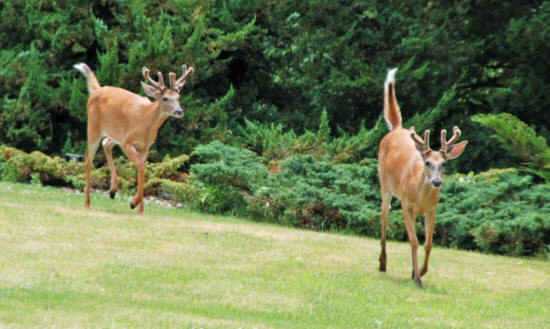|
 Protect
Your Landscape from Hungry Critters Protect
Your Landscape from Hungry Critters
by Melinda Myers
 Send a link to a friend
Send a link to a friend
[June 23, 2020]
While you’re busy filling your landscape with
beautiful flowers and scrumptious vegetables, the deer, rabbits and
other wildlife are watching and waiting to move in to dine. Don’t
lose your beautiful investment to hungry animals. Be proactive in
keeping wildlife at bay, so you can grow a beautiful landscape this
season.
|
|
 Protect plants as soon as they are set in the
ground. It’s easier to prevent damage rather than break a habit.
Once critters find delicious plants, they will be back for more and
they’re likely to bring along a few additional family members. Protect plants as soon as they are set in the
ground. It’s easier to prevent damage rather than break a habit.
Once critters find delicious plants, they will be back for more and
they’re likely to bring along a few additional family members.
A fence is an excellent defense against animals. A four-feet-high
fence anchored tightly to the ground will keep out rabbits.
Five-feet-high fences around small garden areas will usually keep
out deer that tend to avoid smaller spaces.
Woodchucks are more difficult. They will dig under or climb over the
fence. You must place the fence at least 12" below the soil surface
with four to five feet above ground. Make sure gates are secured so
animals can’t squeeze through or under these. The last thing you
want is an animal happily living and dining inside your fenced in
garden.

For gardeners who do not want to spend the money on fencing or view
their flowers and other ornamental plantings through a fence, there
are other options.
Scarecrows, rattling pans and other scare tactics have been widely
used for decades. Unfortunately, urban animals are used to noise and
human scent and not discouraged by these tactics. You must move and
alternate the various scare tactics to increase your chance of
success.
Repellents may be your best and most practical option. Always check
the label for details on use, application rates and timing. Research
has proven that odor-based repellents are more effective than other
types of repellents. Wildlife will avoid plants rather than taking a
bite before they discover they don’t like the taste.
[to top of second column] |

Look for organic repellents labeled for use on food
plants when treating edibles. Plantskydd (plantskydd.com) is the
only OMRI certified organic repellent and is effective against
rabbits, deer, voles, elk, moose, chipmunks and squirrels. It is
rain resistant and each application lasts three to four months
during the growing season.
Maximize results by treating new growth according to
label directions. Most liquid repellents need time to dry while
granule repellents may need to be watered to activate the smell.
Always check the label for the product you are applying.
Protect new tree whips by dipping them in a long-lasting liquid
repellent. Mature trees will benefit as well. Treat them prior to
bud break or two to three weeks after leaves have developed.
Continue to monitor plantings throughout your landscape all season
long. Watch for animal tracks, droppings and other signs wildlife
have moved into your area. Protect new plantings and those favored
by wildlife before they start dining on your plants. Always be as
persistent as the hungry animals.
If you’re ever feeling discouraged, remember that gardeners have
been battling animals in the garden long before us and there are
lots of options to help protect your flowers and harvest.
[Photo courtesy of Melinda Myers, LLC ]
Melinda Myers has written more than 20 gardening books, including
Small Space Gardening. She hosts The Great Courses “How to Grow
Anything” DVD series and the Melinda’s Garden Moment TV & radio
segments. Myers is a columnist and contributing editor for Birds &
Blooms magazine and was commissioned by Tree World Plant Care
Products for her expertise to write this article. Her web site is
www.MelindaMyers.com. |